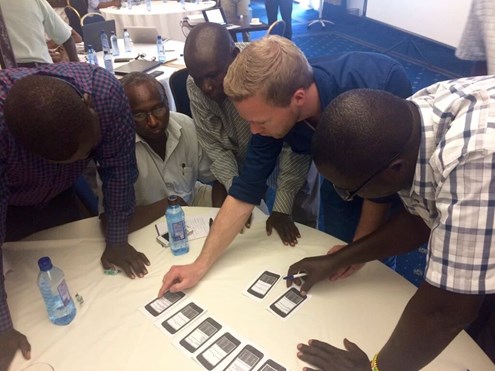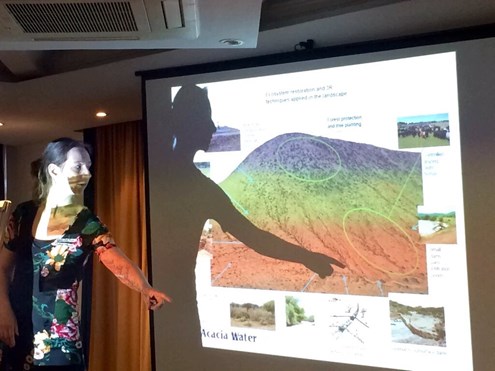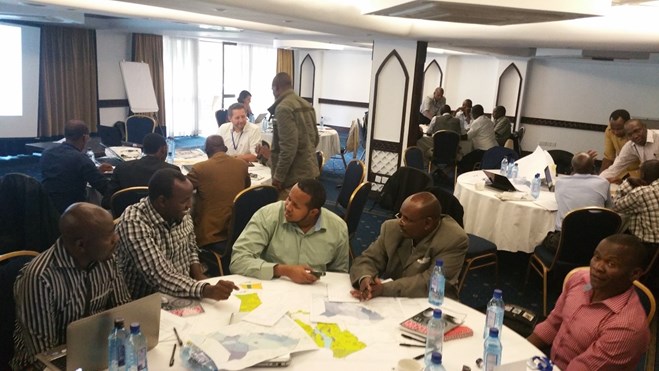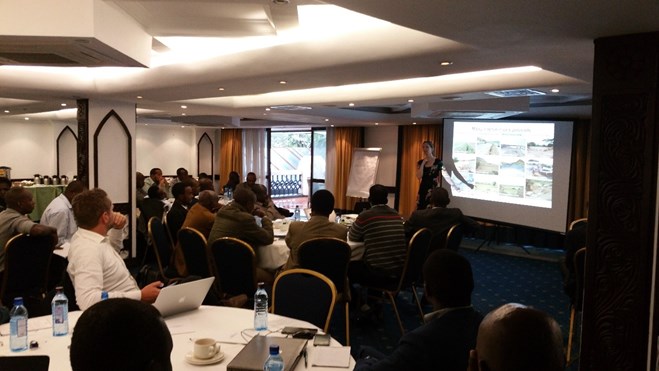From April 25 until 27 Acacia Water was in Nairobi, Kenya, to give a refresher training on the concepts ‘Recharge, Retention and Reuse’ (3R) and ‘Multiple Uses Systems’ (MUS) to approximately 45 county experts and County Coordination Unit (CCU) officers in the field of water, livestock, planning and ICT from Northern Kenya. Aim of the 3-day workshop – part of the Kenya Resilient Arid Lands Partnership for Integrated Development (RAPID) program – was to explore how these approaches can support inclusion of Integrated Water Resources Management (IWRM) principles into the county institutional infrastructure. The workshop furthermore included a validation of a web-based data management tool, which is currently under development.
The first day of the workshop was dedicated to a technical and hydrological analysis of Northern Kenya. Lieselotte Tolk gave a refresher training on several IWRM approaches such as 3R and MUS, which were successfully used in the previous program (2012-2014) Kenya Arid Lands Disaster Risk Reduction - Water Sanitation and Hygiene (KALDRR-WASH). These concepts will continued to be used and upscaled within the Kenya RAPID program.
Stefan de Wildt from Acacia Water then presented the preliminary results of the biophysical analysis and the balance between the resources availability and demand in the counties, especially for water. This provided each county an insight on the theoretical water availability from multiple resources (e.g. precipitation, deep groundwater) and water demand for multiple uses (e.g. domestic, livestock, agriculture).
Promising underground water storage not visible to communities
During the subsequent group discussion per county Acacia Water’s findings were verified, where the need for more local intensification and more reliable census data came to light. From the county planning it appeared the focus is still too often on conventional water abstraction techniques, such as boreholes and water pans. Acacia Water tried to show with help of 3R potential maps that other water buffering techniques and soil & water conservation measures can sometimes be more effective and sustainable. A much-heard comment from the counties was that communities want to see visible water, not water which is stored underground, even though it might be more promising. Clearly, community sensitization about advantages and benefits of 3R techniques is necessary.
The second day of the workshop was focused on the strategic planning process at county level. Lieselotte (Acacia Water) presented the importance of well-informed decision-making, and how such process should look like, followed by a discussion and group work how that currently takes place in the respective counties. This was followed by an overview of technical backstopping that Acacia Water can provide to the counties.
On the third day Mark de Blois from Upande Ltd (Kenya) presented the insights gained from baseline and county surveys regarding ICT and data related gaps and needs at the counties. It assists in exploring how county information needs can be incorporated in the web-based data management tool, and to verify first ideas of its functionality.
“Very educative and interesting workshop on 3R and MUS”
The workshop was received very positively by the audience. As one of the Turkana County representatives said: “Very educative and interesting workshop on 3R and MUS. Good facilitation by Acacia Water”.
In the second week Acacia Water/Stefan de Wildt will go to Marsabit Town in northern central Kenya to visit some of the county departments and experts (Water, Livestock, Agriculture, Planning, ICT). Objective is to evaluate both their short and long-term strategic planning, the translation of planning into practical implementation of interventions, and how a resilient 3R/MUS and catchment approach can be integrated in all of this.








